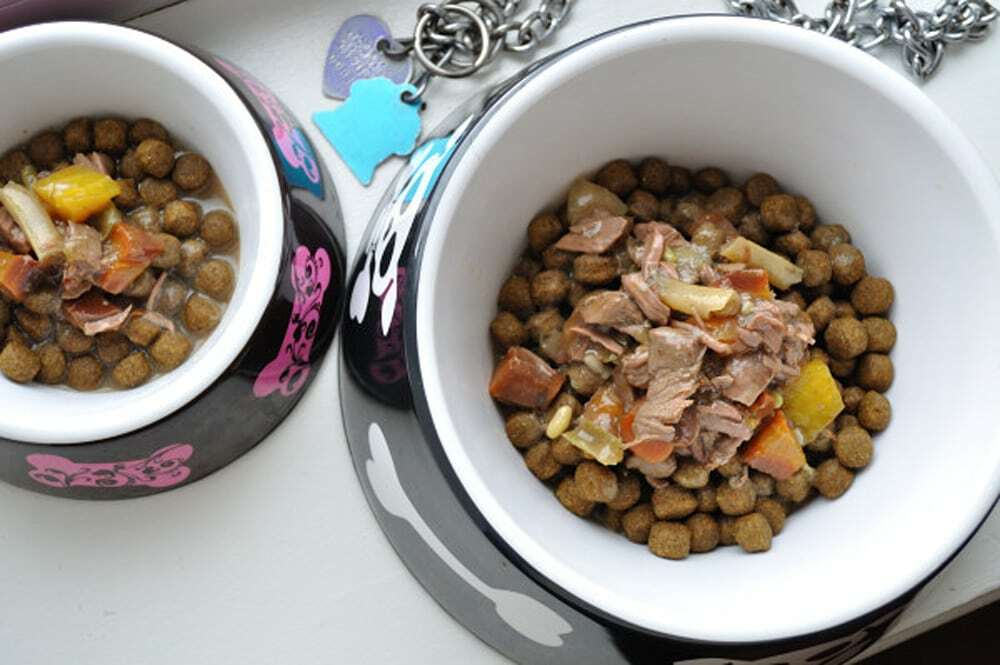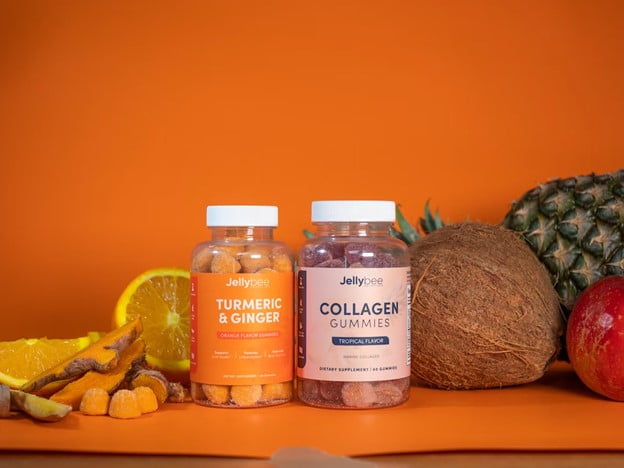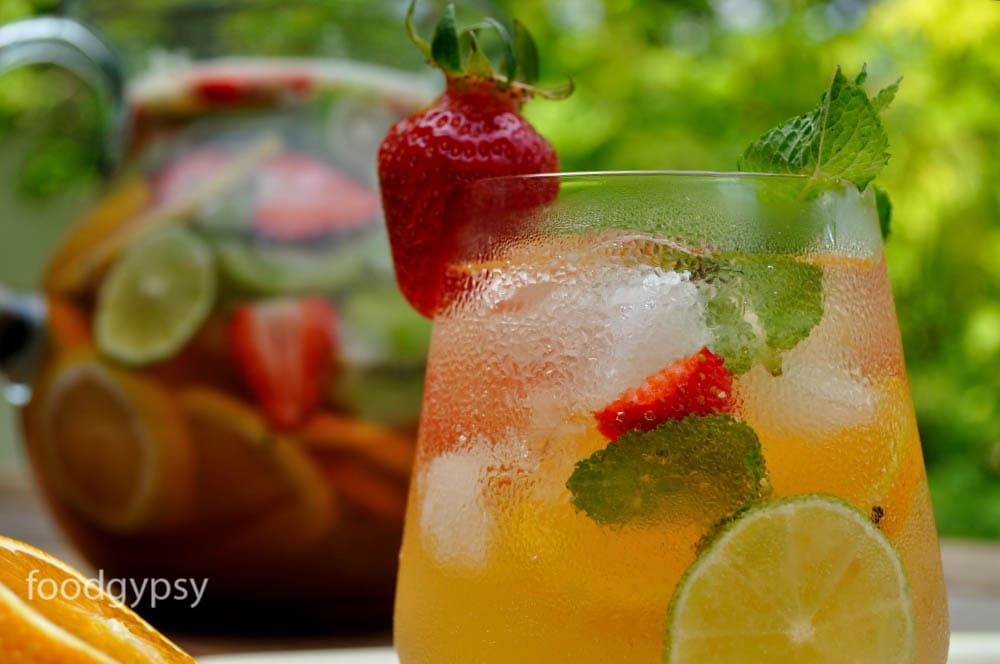As a vegetarian, it's important to make sure you're getting all the nutrients your body…

Cooking for Dogs in the Gypsy Kitchen
Indulged, pampered and spoiled are all adjectives that could apply to my pets. One person’s spoiled is another’s well fed, well loved member of the family. There have been very few times in my life when I was not surrounded by animals, from the household pets of my childhood to the animals of the farm in my teens and the pets that have been my companions in my adult life. It’s good to be an animal under my care.
Some look down their noses when they see me feed a soupy meat based gruel we call doggie stew or a loose slurry of cooked ground beef, grains and berries that supplement their kibble. “oh, my dogs don’t eat HUMAN food” is often said with a load of judgement, as if I have broken the cardinal rule of canine ownership. Dogs have been a constant in my life and their care and feeding has become one of life’s interesting journeys.
The fact is dogs and human’s share a bond and a very similar diet. For the last 3,000 years of domestication, dogs ate what was left for them after their humans had eaten. In 1922 the pet food industry was born and both wet and dry pet foods followed. For many years, dog food was very stable, made from proteins not suitable (or desirable) for human consumption. Dog food was comprised largely of horse and organ meat, course grains, bone meal and essential fats. Again, scraps from our table.
Bits of freezer burnt lamb, marked down beef and leftover fish, wilting vegetables, shriveled up sweet potatoes, the remains of rice, pasta and cooked cereals all find their way into the bellies of waiting canines.
Today a great many things have changed within the pet food industry, new formulation, new technology and of course, the introduction of GMO grains as a list of preservatives and flavour enhancers into a once unpolluted feeding system. Some pets foods have become much, much worse and along side that is a line of gourmet and specialty pet foods to accommodate the many allergies and digestive issues that have become a veterinary concern.
Many pet owners are finding that animals who have never had any kind of allergy in their lives are suffering skin legions, digestive distress and hot spots and vets in record numbers are recommending a change in diet.
The last year has been a roller coaster ride of expensive testing, specialty foods and the stress of nursing the magnificent Magnus The Great, my much loved bulldog, from one health crisis to the next. I’ve read the contents of hundreds of bags of dog food, including single source protein (kangaroo anyone?) and grain-free until we found an option that works, but it ain’t cheap! So we supplement with clean sourced food we can trust, which means I’m cooking for dogs.
Pets are members of our family, often as precious and loved as children so I thought I would take this post to share with you the guidelines of good canine nutrition, should you or someone you know ever find themselves in a similar pinch. Really, their needs are not that different from ours.
- Let’s start with this: fat is good. In canine terms, fats mean energy. Dogs use this energy to build muscle and sustain their daily activities, from hunting and herding to laying around farting. Fats are the most efficient source of energy for a dog, without it they loose muscle.
- Proteins are essential. Meat is the most common protein source in natural dog food, other sources include eggs, milk and plant proteins. Our favorite proteins in the Gypsy Kitchen include beef, chicken and lamb, we avoid pork as it’s the most common bulldog allergy and well, the bacon is MINE.
- Carbohydrates are a necessary source of glucose, which is important for cellular health. If the dog’s diet does not contain an adequate amount, the liver must work overtime to compensate, using proteins to make glucose. Carbohydrates are found primarily in plants such as grains like wheat, barley, corn, rice, cereals and potatoes.
- To aid digestion, all types of carbohydrates need to be boiled, baked or toasted before feeding to a dog. Starches from oats, corn and potatoes in particular are difficult to digest unless cooked. We lean toward brown rice, avoid corn and soy and skip white flesh potatoes in favor of deeper nutrition with sweet potatoes.
- Vitamins & trace minerals are essential for your dog’s health, so if you’re going homemade with your feeding regime, be sure to include a good one.
There are some people foods to avoid all together as they’re toxic to dogs including:
Onions, grapes & raisins, chocolate, coffee & cola and anything caffeinated, macadamia nuts, mushrooms, Xylitol (artificial sweetener found in candy & chewing gum), alcohol and yeast dough, citrus oil extracts, fruit pits and seeds. Also rotten or moldy foods can cause stomach upset, and while not fatal, too much junk food can be just as unhealthy for your dog as they are for you.
One of my favorite sites for dog food recipes is homemdedogfood.com with easy to follow recipes and solid nutritional resources, if you’re looking at doing some cooking for your canine it’s a good bookmark to have.
While accommodating the dietary needs of one dog, the other, Miss Teah a Jack Russel-Chiwawa cross who’s claim to fame is the consumption of an entire tube of Crazy Glue with no (apparent) effects, now has a shinier coat and no longer suffers ear infections. The bulldog LIVES for gravy, it’s his favorite thing!





Thanks for the interesting article about how your cooking has “gone to the dogs”! I don’t cook for my furry kid, but his kibble is supplemented with sardines – the ones with jalapenos, of course! I was curious that you don’t mention fish of any sort, in your discussion about protein. Was that an oversight or simply something that you don’t use for your dogs? Colour me curious!!
Hi El –
Thanks for reading Food Gypsy! We love to hear from readers, always makes my day. Our big, bad bulldog has since passed away, so the canine cooking load is considerably lighter at our house with just the Jack-huahua (Jack Russell Chihuahua mix) to feed. You’re right, I didn’t mention fish in this article, an oversight on my part as I’ve often fed salmon and herring protein to doggie companions in past. However my last three dogs were allergic to fish, so I stopped feeding it. Thanks for your note – I’ll address that omission with a revision. What breed is your dog, I love that he/she loves jalapeno sardines!!!!
If you enjoy a good dog tale, here’s a link to my tribute to Magnus The Great. (Warning: it’s a 2-tissue piece!) It’s been almost 4 years since he passed to the land of gravy & dandelions (two of his favorite things) and I still miss him every single day. https://foodgypsy.ca/a-slice-of-life/lessons-in-greatness-from-one-great-dog/
Dog people are good people…
Be well,
Corinna
Is this diet good for dogs with copper associate disease .
Hi Rhonda –
Not being a veterinarian, I would hate to give you bad advice regarding the right diet for your dog. However I do know that most commercially produced dog foods contain copper as both an additive as well as (often times) large amounts of liver, also high in copper. We still feed our dog (and fosters) this way, high quality kibble with homemade meat/veggie based wet food. They’re healthy, weight controlled and happy.
Longtime dog lover that I am, I hope that you’ve found sound advice for your best friend from your vet.
Best,
Corinna